Abel Tasman National Park is renowned for its world-famous coastal walking track, its golden sand beaches, unmodified estuaries, sculptured granite cliffs and mild climate.
It is a good place to visit at any time of year and during summer the park is particularly popular. The bays become dotted with sea kayaks, sailing boats and other water crafts.
Many people choose to stay in huts or campsites provided by the Department of Conservation (DOC) as they explore the Abel Tasman Track. The track hugs the coast, offering spectacular views as you reach the top of a ridge, then it’s back down to the next sheltered swimming and picnic spot.

View the seals at Tonga Island Marine Reserve
Tonga Island Marine Reserve is the third marine reserve to be created alongside a national park in the Abel Tasman area. This is a great place to go and view wild life, especially the seals.

Cascade Falls
A beautiful waterfall hidden in amongst stunning bush. The river, while cold, is also a good spot to cool off. Cascade Falls is located about 1.5 hours walk from Torrent Bay. This is one of the more difficult tracks as it is quite steep in parts, but it is definitely worth the hike! Set out from Torrent Bay on the high tide track to Anchorage and follow the signs – the turnoff to Cascade Falls is approximately 15 minutes from the Torrent Bay campsite. NOTE: This track is temporary unwalkable.

Falls River Bridge
An impressive 47 m suspension bridge which crosses the Falls River. It is located on the track between Bark Bay and Torrent Bay.

Take a cruise into the park and see it all from the comfort of your boat
You can stop off at one of the beaches for a picnic or swim or walk a section of the park and rejoin your Abel Tasman Sea Shuttle later on in the day for a cruise ride home.

Walk the Abel Tasman Coast Track
The Abel Tasman Coast Track, which suits most ages and most levels of fitness, is 51 kilometres long and most people can walk it in 3 to 5 days with plenty of time to explore. It is accessible at several points.
Many summer holiday makers choose to walk only short sections of the track and may use boat services from Kaiteriteri to return to their starting point.
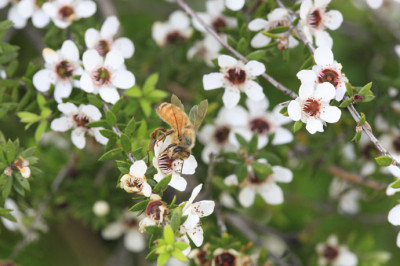
Mānuka / Kāhikatoa
Mānuka or kāhikatoa (Leptospermum scoparium), called ‘tea tree’ by Captain Cook, is a rather variable plant ranging from flat creeping forms and small shrubs to tall trees (up to 10 m tall).
Although variable, all the forms of this species are unified by their sharp-tipped leaves, large, solitary white or pink-flushed flowers, with distinctive short, dark red stamens, and persistent greyish-white nut-like capsules. Mānuka / kāhikatoa plants are sometimes covered with sooty mould, a black fungus that feeds on the honeydew produced by scale insects.
Early settlers battled hard to clear their land and regarded mānuka / kāhikatoa as invasive shrubs that undid all of their hard work. Today however, these plants can act as an important tool for re-vegetating bare, eroded slopes. By creating shade and shelter from the wind, they provide an excellent nursery for other, slower growing native plants. Then, as these other plants get taller and overtop them, the mānuka / kāhikatoa die away as a result of being shaded.
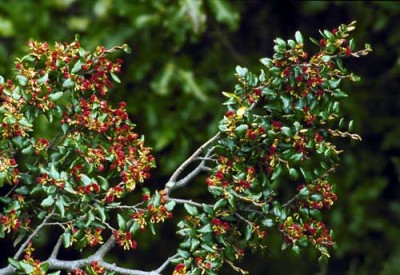
Black Beech (Tawhairauriki)
Black beech (Nothofagus solandri) are found in the lowland areas of the North Island and northern South Island.Beech trees flower in spring and are wind pollinated. After fertilisation, beech flowers produce seeds in the form of small winged nuts which fall in autumn.
The seeds rarely blow more than a few metres before falling to the forest floor where they germinate the following spring. The half light of the forest floor stunts the growth of seedlings until a mature tree falls and light floods in. Once established, a beech tree can grow over 30 metres tall and can live for more than 300 years.
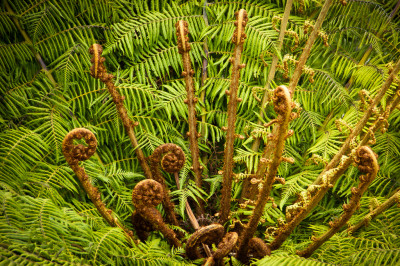
Ferns
Ferns are mostly a tropical group, and New Zealand has an unusually high number of species for a temperate country. We have about 200 species, ranging from ten-metre-high tree ferns to filmy ferns just 20 millimetres long. About 40 per cent of these species occur nowhere else in the world.
Ferns are typically found in moist, forested areas because they require lots of water. Ferns are abundant in all damp situations in New Zealand forests, forming the undergrowth beneath a dense canopy of evergreen trees. They are also found growing on tree trunks and branches and along stream banks. Some hardy species have adapted to other drier habitats such as coastal, alpine, urban and even desert locations.
The leaves of ferns are called fronds and when they are young they are tightly coiled into a tight spiral. This shape, called a ‘koru’ in Māori, is a popular motif in many New Zealand designs.
The Silver Fern or Ponga is a national symbol and is named for the silver underside of its fronds.

Kōwhai Tree
The Kōwhai is one of the best known native trees in New Zealand and it’s our unofficial national flower.
Kōwhai grow from a seed in the ground to become a tree up to 25 metres high. It’s found throughout New Zealand in a diverse range of habitats from riparian forests, coastal cliff faces to inland grey scrub communities.
Kōwhai are best known for their brilliant yellow flowers that appear in profusion in Spring and stand out among the forest greenery.
Native birds such as the tui, bellbird, kākā and New Zealand pigeon/kererū/kūkū/kūkupa all benefit from kōwhai trees.

Rata Tree
Rata trees, along with the pohutukawa, are one of the best known native trees in New Zealand. The rata and pohutukawa belong in the myrtle family of trees. Other members of this family include manuka, kanuka and swamp maire. There are two main types of rata, the northern and southern.
Rata trees have glossy dark green leaves and trunks that are often gnarled and twisted. However they are best known for their brilliant red flowers that appear in profusion from November to January, depending on location, and can be seen from some distance away. The trees tend to flower well only once every few years and seem to favour the high rainfall conditions of the West Coast. Native birds such as the tui, bellbird and kaka all benefit from the presence of rata trees in the forest.

Longfin Eels (Ōrea)
Longfin eels can be found throughout New Zealand. They live mainly in rivers and inland lakes but can be found in almost all types of waters, usually well inland from the coast.
They are legendary climbers and have made their way well inland in most river systems, even those with natural barriers. Elvers (young eels) swimming up river will climb waterfalls and even dams by leaving the water and wriggling over damp areas. It is not unheard of for an eel to climb a waterfall of up to 20 metres.
When eels begin life, they are a tiny one millimetre in length. During their life, they can grow up to two metres long.
Compared with many other fish, eels are slow growing – a longfin may grow only between 15-25mm a year. They can also live for many years. Large longfins have been estimated to be at least 60 years old.
The biggest eels are usually old females that have been slow to reach sexual maturity and, for reasons that are not yet understood, have not migrated to sea to breed.

Whitebait (Inanga)
The small fish caught each spring by whitebaiters all around the country are actually the juveniles of five species of fish. They are banded Kokopu, Giant Kokopu, Inanga, Koaro and Shortjawed Kokopu.
These five are part of a group of fish called galaxiids (so called because of the patterns of their skin which look like a galaxy of stars) of which there are 20 species, the rest of which don’t migrate.
Those that escape the whitebait net grow into silvery, slender adults (about 9 cm long). They spawn in streamside vegetation, even rank exotic grasses are suitable.
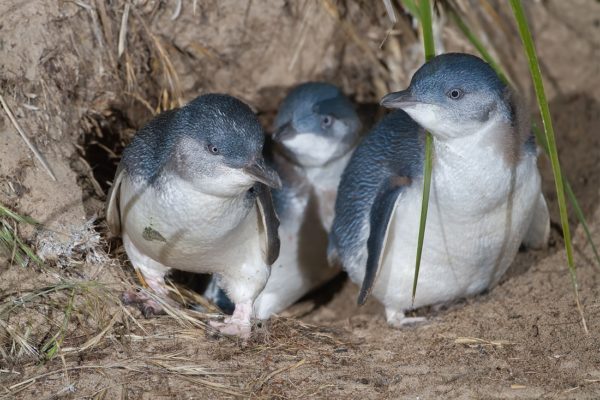
Little Blue Penguin (Kororā)
The world’s smallest penguin, little penguin (also known as little blue penguin) stand just over 25 cm and weigh around 1 kg. The plumage is slate-blue with a bright white belly. They are found on most of New Zealand’s coastline and in southern Australia.
They spend much of their time at sea hunting small fish, crustaceans and squid. Like all penguins they cannot fly, but their paddle-like flippers are excellent for ‘flying’ through the water.Little penguins forage for food up to 25 km offshore and 70 km from the colony.They can reach speeds of up to 6 kph underwater. Little penguins only come ashore under the cover of darkness and live underground in burrows, natural holes, or under human structures or buildings.
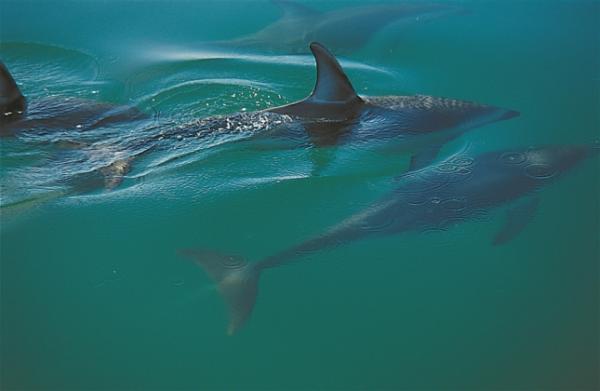
Common Dolphin (Aihe)
Common dolphins found in New Zealand waters belong to the species now known as the short-beaked common dolphin. The colouration of this dolphin is very distinctive with a criss-cross or hour-glass type pattern centred on the flanks. Colours include purplish black, grey, white and yellowish tan. The dorsal fin is high with a concave hind edge. The head is low and smooth-sloping.

New Zealand Fur Seal (Kekeno)
New Zealand Fur Seal are the most common seals in New Zealand waters. They are very good swimmers and weaned pups will turn up almost anywhere around New Zealand. A Fur Seal pup tagged on the west coast of South Island has even been recorded in Australia. On land they sometimes become disoriented and have been found in unusual places such as back-yards, drains and streets.

Oystercatcher (Tōrea pango)
Oystercatchers are stocky birds with bright eye-rings and long colourful bills. Their diet is much more varied than their name implies. There are three species in New Zealand.
The pied oystercatcher or torea is the most common oystercatcher in New Zealand, numbering around 112,000 birds in 1994.The New Zealand subspecies (Haematopus ostralegus finschi) is the South Island pied oystercatcher or SIPO. It has a black head and upper surfaces, and a white belly.The variable oystercatcher (Haematopus unicolor, torea or toreapango) is found on rocky and sandy beaches. It is rare – there were around 3,500 birds in 1994, and they are found only in New Zealand.With a population of only 220 birds in 2004, the endemic Chatham Island oystercatcher (Haematopus chathamensis) is endangered.This species is confined to the Chatham Islands and South East and Pitt islands. They measure 48 centimetres and weigh 600 grams.
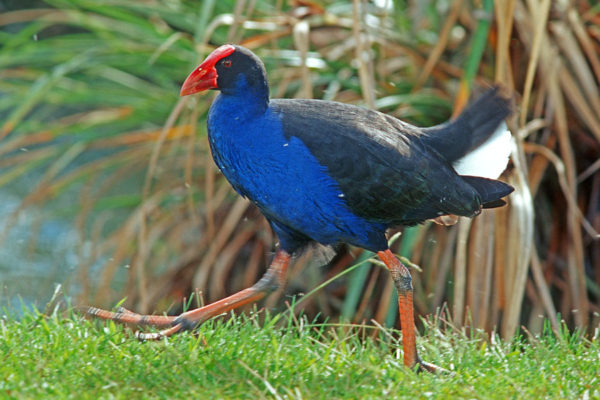
Pūkeko
Pūkeko are probably one of the most recognised native birds in New Zealand with its distinctive colourings and habit of feeding on the ground. It is found all over New Zealand.
Commonly seen along marshy roadsides and low-lying open country, the bird’s range has increased with agricultural development. Unlike many other native birds, the pūkeko has adapted well to new habitats, such as grassed paddocks, croplands and even city parks, a necessity brought about by disappearing wetlands. However, the pūkeko is essentially a bird of swampy ground, lagoons, reeds, rushes and swamps.

Paradise Ducks (Pūtakitaki)
The paradise shelduck is New Zealand’s only shelduck, a worldwide group of large, often semi-terrestrial waterfowl that have goose-like features. Unusually for ducks, the female paradise shelduck is more eye-catching than the male; females have a pure white head and chestnut-coloured body, while males have a dark grey body and black head.
Paradise shelducks are commonly observed flying in pairs or grazing on pasture. They are very vocal birds, with males giving a characteristic ‘zonk zonk’, while females make a more shrill ‘zeek zeek’ while flying or as a warning to intruders.

Bellbird (Korimako)
Most New Zealanders can easily recognise the bellbird by its melodious song, which Captain Cook described as sounding ‘like small bells exquisitely tuned’.
Well camouflaged, the bellbird is usually heard before it is seen. Females are dull olive-brown, with a slight blue sheen on the head and a pale yellow cheek stripe. Males are olive green, with a purplish head and black outer wing and tail feathers.

Native Wood Pigeon (Kererū)
New Zealand’s native pigeon, also known as kererū, kūkū and kūkupa and wood pigeon, is the only disperser of large fruits, such as those of karaka and taraire.
The kererū is a large bird with irridescent green and bronze feathers on its head and a smart white vest.The noisy beat of its wings is a distinctive sound in our forests. The pigeon is found in most lowland native forests of the North, South and Stewart/Rakiura islands and many of their neighbouring islands.

Tui (Tūī)
Tūī are common throughout New Zealand in forests, towns and on off-shore islands. They are adaptable and are found not only in native forests, bush reserves and bush remnants but also in suburban areas, particularly in winter if there is a flowering gum about.
These attractive birds can often be heard singing their beautiful melodies long before they are spotted. If you are fortunate to glimpse one you will recognise them by their distinctive white tuft under their throat, which contrasts dramatically with the metallic blue-green sheen to their underlying black colour.

Fantail (Pīwakawaka)
Known for its friendly ‘cheet cheet’ call and energetic flying antics, the aptly named fantail is one of the most common and widely distributed native birds on the New Zealand mainland.
It is easily recognized by its long tail which opens to a fan. It has a small head and bill and has two colour forms, pied and melanistic or black. The pied birds are grey-brown with white and black bands.

Totaranui
Totaranui is located in Abel Tasman National Park toward the northern end of the Abel Tasman Track and is often used as a starting or finishing point for walking and kayaking the track/park. The beaches to the South are Goat Bay, Waiharakeke Bay, and Awaroa Bay; to the North is Anapai Bay, Mutton Cove, and Separation Point which separates Able Tasman National Park from Golden Bay.
Totaranui bay has some of the best stands of native bush left in the National Park and its golden beach and clear waters have seen it become a summer holiday favourite for New Zealanders seeking sun and sea.

Awaroa
The Awaroa Wildlife Management Reserve occupies 308 ha on the floodplain associated with the Awaroa Stream, from where this stream enters Lake Whangape to 2.3 km upstream. Most of the reserve is covered by crack willow forest or by open swamp dominated by flax, cabbage tree, manuka, and Coprosma propinqua.
Awaroa Lodge is located in the heart of the Abel Tasman National Park with no road access! It has accommodation, restaurant and a bar. You can enjoy a number of activities while staying there. You can stroll around the beach, walk the coastal track, kayak, fish or sail and do a lot more.

Tonga Island Marine Reserve
Tonga Island Marine Reserve exists between Bark Bay in the south and Awaroa Bay in the north. The reserve boundary reaches one nautical mile out to sea. Fishing or collecting shellfish in the reserve is strictly prohibited with stiff penalties for those caught breaking the rules. The reserve is named for the island it is based around which supports a year round Fur Seal population.
The clear warm waters of the reserve make it incredibly popular with kayakers and swimmers, and trampers on the coastal track will sometimes pop into the water with a snorkel to cool off. Underwater visitors will see tumbled rock and bedrock reefs, inhabited by numerous grazing invertebrates, with sandy-bottoms extending beyond.
Kayakers will often see little blue penguins along this coast and may occasionally be rewarded with an encounter with a pod of dolphins. Because many local estuaries are also protected, visitors may see some of New Zealand’s rarer shorebirds.

Bark Bay
The views between Torrent Bay and Bark Bay are some of the most stunning views you can find in the Abel Tasman National Park. At the northern end of Torrent Bay beach the track climbs steadily and then sidles around two valleys and above a beautiful inlet to Falls River, the biggest in the park, which is crossed by a 47 m suspension bridge. Beyond the river, the track meanders through lush coastal forest before dropping back to the sea. Follow the track to the hut and campsite beside Bark Bay estuary. In Bark Bay, with it’s sheltered camp site, you can relax, swim in the crystal clear water, sunbathe or or relax in the shady forest canopy.

Anchorage
Anchorage is the only bay with a number of different accommodation options from DOC campsites & huts to a boat stay.From Anchorage you can access the popular Pitt Head walk which is approximately an hour return.
Anchorage campsite is a walk-in or boat-in campsite on the southern section of the Abel Tasman Coast Track. There is no drive in access.
Beachside campsite. Anchorage has great facilities, but is also busier. It is especially busy in summer with pick-ups of kayaks and day walkers by water taxis.
Popular campsite for school groups, especially on Monday to Thursday nights in November and mid-February to April.

Adele Island
The Abel Tasman Birdsong Trust (set up in 2007), a partnership between the community, park tourist operators and D.O.C, maintains the trapping and predator monitoring network on Adele which is in place to catch predators that get onto the island. It also has trap lines on the park coast to prevent predators swimming to Adele, just 800 metres from the coast, and nearby predator-free Fisherman Island.
D.O.C carried out rodent eradication on the park’s Adele, Fisherman and Tonga Islands in 2007 to pave the way for their ecological restoration and for their use as island wildlife refuges. Stoats were removed from 87-hectare Adele Island through trapping assisted by the Marahau community.
Now Adele Island is the home to a large varieties of wildlife especially birdlife.So come take a walk and listen to the beautiful birdsong.

Kaiteriteri Beach
Kaiteriteri Beach is definitely one of New Zealand’s best beach holiday destinations. It’s famous for its glittering golden sands, its beautiful blue-green water and many varieties of wildlife. Kaiteriteri beach is a favourite holiday destination for both New Zealanders and international tourists alike.
Kaiteriteri is known as the Gateway to the Abel Tasman National Park. Located in the scenic Nelson/Tasman region of New Zealand, Kaiteriteri beach has some of the highest sunshine hours in New Zealand,which also provides Kaiteriteri with many great activities and attractions for you while you’re on holiday here all year around.
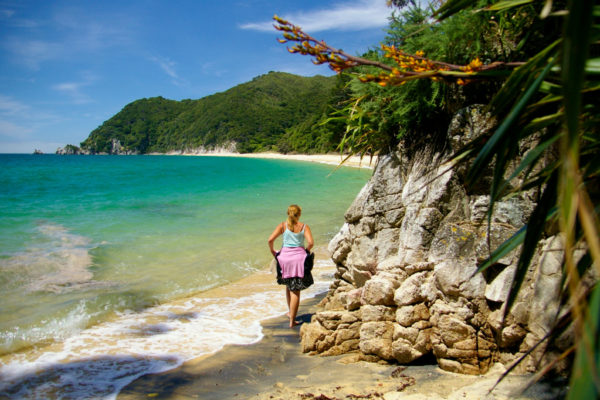
Whariwharangi to Wainui
Time: 1 hr 30 min
Distance: 5.5 km
From Whariwharangi Hut follow a small stream then climb out of the bay to a saddle overlooking Wainui Inlet. The track winds down to the shore around gorse-covered ridges recovering from a 1978 fire, then follows the estuary edge for 500 metres to the carpark. It is possible to cross Wainui Inlet within two hours either side of low tide.
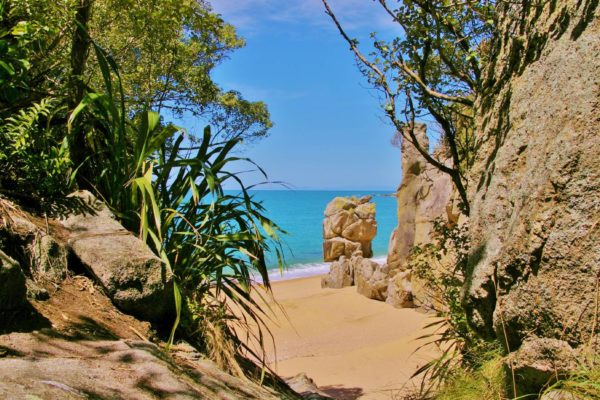
Totaranui to Whariwharangi
Time: 3 hr
Distance: 7.5 km
The track heads around Totaranui estuary, climbs over a low saddle and winds down through lush forest to Anapai Bay. From here to Mutton Cove, travel alternates between sandy beaches and rocky headlands of regenerating Kanuka.
Leave the coast at Mutton Cove and climb to another saddle. From here the track descends to Whariwharangi Bay. Add 1 hour to travel via Separation Point. The hut a restored farm homestead and campsite are just behind the beach.

Awaroa to Totaranui
Time: 2 hr 30 min
Distance: 5.5 km (tidal)
Awaroa Estuary can only be crossed close to low tide. The estuary should definitely only be crossed up to one and a half hours before low tide and up to two hours after it. (Following very heavy rain the estuary may be impassable.) From its northern side the track crosses a low saddle and drops to Waiharakeke Bay, where a timber mill once operated.
The track re-enters the forest then emerges at Goat Bay, from where it climbs then descends to a lookout above Skinner Point before descending to Totaranui. Follow the road through the main camping ground to the camp office, Sea Shuttle pickup point and Coast Track walkers campsite.

Bark Bay to Awaroa
Time: 3 hr
Distance: 11.4 km (tidal)
Cross Bark Bay estuary or follow the all-tide track around its edge and climb steeply to a saddle. Here you lose all sense of the sea below as you journey through stands of Manuka.
Return to the shore at Tonga Quarry, where blocks of granite remain from an old quarrying operation. Tonga Island sits offshore surrounded by marine reserve. A short distance on is Onetahuti Bay. The track then climbs over Tonga Saddle and descends to Awaroa Inlet. Follow the shore for 15 minutes to Awaroa Hut and campsite.

Sandfly Bay
A steep 5 minute scramble about 30 minutes before Bark Bay takes you down to the secluded and very scenic Sandfly Bay (don’t let the name put you off!)

Falls River
A track heads inland from near Torrent Bay Village camp to the Falls River falls. Allow 3 hours return. A shorter option for those with less time is the Cascade Falls on the same track. Allow 1 hour 30 minutes return.

Te Pukatea / Pitt Head
A 20 minute walk crosses a low ridge from Anchorage Hut to crescent-shaped Te Pukatea Bay. From there a 1 hour walk with good views leads to Pitt Head, an old pa site, and back to Anchorage.

Tinline Bay Nature Walk
From the campsite a 20 minute loop track leads up Tinline Creek meandering through lowland coastal forest.

Marahau to Anchorage
Time: 4 hr
Distance: 12.4 km
French names left by Dumont d’Urville and his crew add character to this part of the journey. At the Marahau information kiosk, a causeway crosses the estuary. On the far side of the estuary the track passes through open country to Tinline Bay.
The track rounds Guilbert Point to Apple Tree Bay then passes through beech forest with large kanuka trees. After Yellow Point it turns inland, winding in and out of several little gullies before emerging in open country overlooking Torrent Bay and the coast and islands to the north.
Descend to Anchorage Bay where there is a hut and campsite.
Gallery & Videos
See more of the stunning Abel Tasman National Park. We have a series of videos and a image gallery that will give you a closer look into the expanse and uniqueness of this amazing area.
Environment & Community
We get to work, live and play in an amazing place, so it is important to us to help ensure that it stays amazing. We contribute to essential Trusts, school groups, students and charities.
We also cover the EAF (Environmental Access Fee) for every booking. This fee directly improves the park for future generations.
Project Janszoon
Donations in kind to facilitate schools and students to carry out conservation work in the Abel Tasman National Park.
Abel Tasman Birdsong Trust
Donations in kind to transport volunteers into the Abel Tasman National Park by water taxi.
Charity Cruises
Money raised for the local community by running d’Urville Island Charity Cruises with the Rotary every year.
Schools and Conservation
Subsidise water taxi transport for school groups and students to the value of…
